Online Gather.town Pitches
Image Reconstruction III
Joint Annual Meeting ISMRM-ESMRMB & ISMRT 31st Annual Meeting • 07-12 May 2022 • London, UK

| Booth # | ||||
|---|---|---|---|---|
4044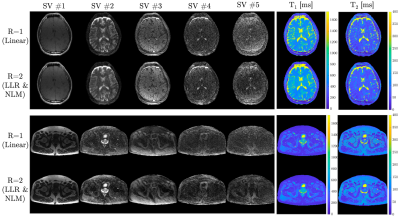 |
1 | Low-Rank Inversion Reconstruction for Through-Plane Accelerated Radial MR Fingerprinting at 0.35T Video Not Available
Nikolai J Mickevicius1 and Carri K Glide-Hurst1
1Department of Human Oncology, University of Wisconsin-Madison, Madison, WI, United States
To reduce scan time, methods to accelerate hybrid phase encoded/non-Cartesian MR fingerprinting (MRF) acquisitions for variable density spiral acquisitions have recently been developed. These methods are not applicable to MRF acquisitions wherein a single k-space spoke is acquired per frame. Therefore, we describe, implement, and test a low-rank inversion method on a 0.35T MR-guided radiation therapy system to resolve MR fingerprinting contrast dynamics from through-plane accelerated Cartesian/radial measurements.
|
||
4045 |
2 | Sinogram Transformers: Accelerating Radial MRI using Vision Transformers
David Parra1, Phillip Martin2, Maria Altbach3,4, and Ali Bilgin2,3,4,5
1Computer Science, University of Arizona, Tucson, AZ, United States, 2Electrical and Computer Engineering, University of Arizona, Tucson, AZ, United States, 3Biomedical Engineering, University of Arizona, Tucson, AZ, United States, 4Medical Imaging, University of Arizona, Tucson, AZ, United States, 5Applied Mathematics, University of Arizona, Tucson, AZ, United States
The aim of this work is to investigate the used of Transformer architectures in radial image reconstruction. While most deep-learning image reconstruction methods are based on convolutional neural networks (CNNs), recent advances in computer vision suggest that Transformer architecture may provide a favorable alternative in many vision tasks. In this work, we demonstrate that Transformer architectures can be used for sinogram interpolation and yield results comparable to CNNs.
|
||
4046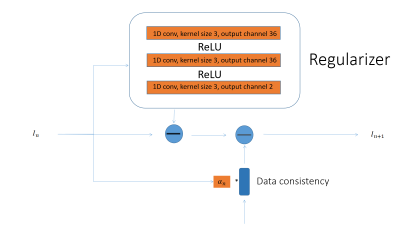 |
3 | 1D Convolutional Neural Network as Regularizer for Learning DCE-MRI Reconstruction
Zhengnan Huang1,2, Jonghyun Bae1,2, Eddy Solomon3, Linda Moy1,2, Sungheon Gene Kim3, Patricia M. Johnson1, and Florian Knoll1,4
1Center for Biomedical Imaging, Radiology, New York University School of Medicine, New York, NY, United States, 2Vilcek Institute of Graduate Biomedical Sciences, New York University School of Medicine, New York, NY, United States, 3Department of Radiology, Weill Cornell Medical College, New York, NY, United States, 4Friedrich-Alexander-University of Erlangen-Nürnberg, Erlangen, Germany
We proposed to use a variational network (VN) reconstruction algorithm with a 1-dimensional convolutional neural network (CNN) as a temporal regularizer for DCE-MRI reconstruction in this study. We used our newly developed breast perfusion simulation pipeline, to generate simulate data and train the reconstruction model. The machine learning (ML) reconstruction shows non-inferior structural similarity and improved visual image quality when compared with the iGRASP reconstruction. The ML reconstruction also takes much less time than the iGRASP reconstruction.
|
||
4047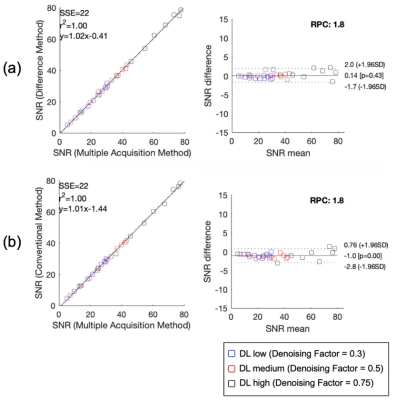 |
4 | Practical Approaches to the Evaluation of Signal-to-Noise Ratio Performance with Deep Learning Denoising Image Reconstruction
Zihan Wang1,2, Jayse M Weaver2,3, Daiki Tamada, PhD2,3, Diego Hernando, PhD2,3, and Scott B Reeder, MD, PhD1,2,3,4,5
1Biomedical Engineering, University of Wisconsin-Madison, Madison, WI, United States, 2Radiology, University of Wisconsin-Madison, Madison, WI, United States, 3Medical Physics, University of Wisconsin-Madison, Madison, WI, United States, 4Medicine, University of Wisconsin-Madison, Madison, WI, United States, 5Emergency Medicine, University of Wisconsin-Madison, Madison, WI, United States
In this work, three methods for measuring signal-to-noise ratio (SNR) performance of deep learning (DL) denoising image reconstruction were evaluated. Images reconstructed using a vendor prototype DL reconstruction algorithm were compared to conventional Fourier reconstruction. Phantom experiments were performed using a single-channel head coil and a 32-channel head coil to assess the effects of parallel imaging acceleration in combination with DL reconstruction on SNR performance. We found excellent agreement between the three SNR measurement methods for both Fourier and DL reconstruction, and found that DL reconstructed images have similar g-factor performance patterns as Fourier reconstructed images.
|
||
4048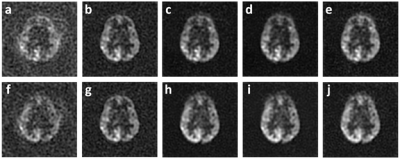 |
5 | Deep Learning for under-sampled non-cartesian ASL MRI reconstruction
Yanchen Guo1, Shichun Chen1, Li Zhao2, Manuel Taso3, David C. Alsop3, and Weiying Dai1
1Computer Science, State University of New York at Binghamton, Binghamton, NY, United States, 2Zhejiang University, Hangzhou, China, 3Beth Israel Deaconess Medical Center and Harvard Medical School, Boston, MA, United States Compressed sensing allowed speeding up MRI image acquisition by several folds but with increased reconstruction time. Deep-learning was introduced for fast reconstruction with comparable or improved reconstruction quality. However, its applications on non-cartesian grids are scarce, mostly based on simulated resampling from original Cartesian grids. Here, we evaluated the performance of two deep-learning networks for reconstructing images acquired with k-space spiral trajectories in real MRI scanning. We demonstrated that deep learning networks can successfully reconstruct high-resolution images from under-sampled spiral trajectories with half of data in k-space and their performance is robust to spiral trajectories different from training. |
||
4049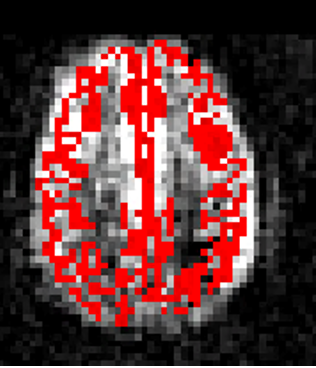 |
6 | ASL with Partial Separability to Incorporate SVD Denoising into the Reconstruction Algorithm Video Permission Withheld
Charles John Marchini1 and Brad Sutton 1
1Bioengineering, University of Illinois Urbana-Champaign, Urbana, IL, United States
ASL methods result in low SNR. SVD denoising can be used to increase the temporal SNR of ASL data by throwing out the low energy singular values. The SVD can be done after a standard reconstruction, or as we show here during the reconstruction if partial separability is used. The incorporation of the SVD into the reconstruction algorithm allows for a higher tSNR within the gray matter. It also paves the path for future work in which subsampling the data results in higher temporal and spatial resolution ASL.
|
||
4050 |
7 | Voxel-wise Temporal Attention Network and Simulation-Driven Dynamic MRI Sequence Reconstruction
Shouchang Guo1, Jeffrey A. Fessler1, and Douglas C. Noll2
1Electrical Engineering and Computer Science, University of Michigan, Ann Arbor, MI, United States, 2Biomedical Engineering, University of Michigan, Ann Arbor, MI, United States
Inspired by two open questions of dynamic MRI reconstruction, we propose a novel voxel-wise attention network for temporal modeling for the undersampled reconstruction. The voxel-wise design of the network enables voxel-wise training, and we further propose a two-stage training scheme that pretrains the network with voxel-wise simulated data when dynamics are easy to obtain with physical models. With a factor of 12 undersampling, our proposed model outperforms other reconstructions with higher PSNR and better fMRI performance.
|
||
4051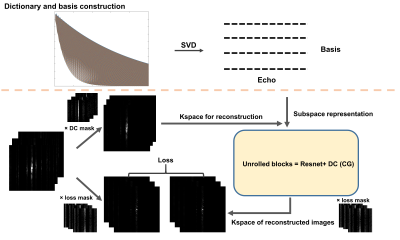 |
8 | Zero-Shot Self-Supervised Learning for 2D T2-shuffling MRI Reconstruction
Molin Zhang1, Junshen Xu1, Yamin Arefeen1, and Elfar Adalsteinsson1,2,3
1EECS, MIT, Cambridge, MA, United States, 2Harvard-MIT Health Sciences and Technology, MIT, Cambridge, MA, United States, 3Institute for Medical Engineering and Science, MIT, Cambridge, MA, United States
Resolving a time series of T2-weighted images from a fast-spin-echo (FSE) sequence with traditional techniques requires long acquisitions, but T2-shuffling enables clinically feasible scan times by combining subspace models, which reduce degrees-of-freedom, with random spatial and temporal undersampling. Supervised machine learning achieves impressive reconstruction, but lack of labeled training data preclude its use in reconstructing signal dynamics. Recent zero-shot-self-supervised-learning (ZSSS) techniques enable high quality structural MRI reconstruction without training data. In this work, we combine ZSSS with the subspace model to further accelerate 2D T2-shuffling acquisitions. Our ZSSS-subspace models show significant reconstruction improvement in comparison to standard T2-shuffling in simulation.
|
||
4052 |
9 | Optimizing k-space averaging patterns for advanced denoising-reconstruction methods
Jiayang Wang1 and Justin P. Haldar1
1Signal and Image Processing Institute, Ming Hsieh Department of Electrical and Computer Engineering, University of Southern California, Los Angeles, CA, United States
This work investigates the potential value of combining non-uniform k-space averaging with advanced nonlinear image denoising-reconstruction methods in the context of low-SNR MRI. A new data-driven strategy for optimizing the k-space averaging pattern is proposed, and is then applied to total variation and U-net reconstruction methods. It is observed that non-uniform k-space averaging (with substantially more averaging at the center of k-space) is preferred for both reconstruction approaches, although the distribution of averages varies substantially depending on the noise level and the reconstruction method. We expect that these results will be informative for a wide range of low-SNR MRI applications.
|
||
4053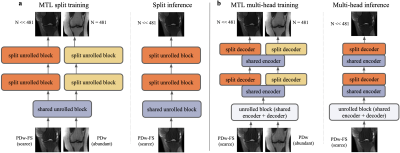 |
10 | Multi-Task Accelerated MR Reconstruction Schemes for Jointly Training Multiple Contrasts
Victoria Liu1, Kanghyun Ryu2, Cagan Alkan2, John Pauly2, and Shreyas Vasanawala2
1California Institute of Technology, Pasadena, CA, United States, 2Stanford University, Stanford, CA, United States
Model-based accelerated MRI reconstruction networks leverage large datasets to reconstruct diagnostic-quality images from undersampled k-space. To deal with inherent dataset variability, the current paradigm trains separate models for each dataset. This is a demanding process and cannot exploit information that may be shared amongst datasets. In response, we propose multi-task learning (MTL) schemes that jointly reconstruct multiple datasets. Introducing inductive biases to the network allows for positive information sharing. We test MTL architectures and weighted loss functions against single task learning (STL). Our results suggest that MTL can outperform STL across a range of dataset ratios for two knee contrasts.
|
||
4054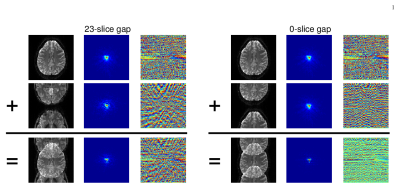 |
11 | On the relationship between slice-GRAPPA, LeakBlock, and in-plane GRAPPA in the reconstruction of accelerated MRI data
W. Scott Hoge1,2 and Jonathan R. Polimeni2,3
1Radiology, Brigham and Women's Hospital, Boston, MA, United States, 2Dept of Radiology, Harvard Medical School, Boston, MA, United States, 3Athinoula A. Martinos Center for Biomedical Imaging, Massachusetts General Hospital, Charlestown, MA, United States The structural relationship between the linear system of equations used to calibrate inplane-GRAPPA, slice-GRAPPA, and LeakBlock for SMS is analyzed. This analysis reveals that LeakBlock is structurally identical to inplane-GRAPPA in the specific case of a (synthetic) zero-slice-gap. Signal leakage in the original slice-GRAPPA formulation is thus revealed to be due to signal cancellation in the original formulation. This relationship between inplane-GRAPPA and LeakBlock further justifies its preferred usage over the original slice-GRAPPA formulation for the separation of slice-accelerated data. |
||
4055 |
12 | Effective removal of aliasing artifacts in accelerated echo-planar imaging (EPI) based functional MRI (fMRI)
Silu Han1, Chidi Patrick Ugonna1, and Nan-kuei Chen1,2
1Biomedical Engineering Department, The University of Arizona, Tucson, AZ, United States, 2Medical Imaging Department, The University of Arizona, Tucson, AZ, United States
An integrated post-processing algorithm has been developed for effectively removing various types of aliasing artifact due to consecutive echo asymmetry, in-plane k-space under-sampling, through-plane acceleration with multi-band (MB) imaging and motion-induced phase variations in EPI based fMRI data. This algorithm uses a novel two-dimensional (2D) coil-signature-based phase-cycled correction method for 2D Nyquist artifact removal without calibration scans, and is capable of simultaneously removing: (1) aliasing artifacts due to in-plane and through-plane acceleration in single-shot and multi-shot EPI; (2) motion-induced phase errors in multi-shot EPI. Experimental results illustrate the effectiveness of the developed method, and its successful application to fMRI studies.
|
||
4056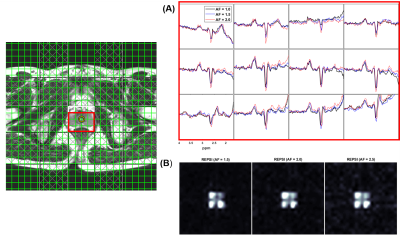 |
13 | Accelerated Radial Echo Planar Spectroscopic Imaging in Healthy Prostate with a Reduced Field-of-View
Andres Saucedo1 and M. Albert Thomas1
1Radiological Sciences, University of California, Los Angeles, Los Angeles, CA, United States
Radial echo planar spectroscopic imaging (REPSI) is applied in healthy prostate and compared to Cartesian EPSI acquisitions. Due to the small spatial extent of the anatomy-of-interest, REPSI is well-suited for acceleration in a reduced-field-of-view context. In this proof-of-concept study, we acquired both prospectively and retrospectively undersampled REPSI and Cartesian EPSI datasets in prostate phantom and in vivo, at multiple acceleration factors, and we compared both quantitative and qualitative results.
|
||
4057 |
14 | Two-Step Semi-Supervised Denoising for Low-field Diffusion MRI
Jo Schlemper1, Neel Dey2, Seyed Sadegh Mohseni Salehi1, Kevin Sheth3, W. Taylor Kimberly4, and Michal Sofka1
1Hyperfine, Guilford, CT, United States, 2New York University, New York City, NY, United States, 3Yale University, New Haven, CT, United States, 4Massachusetts General Hospital, Boston, MA, United States
In clinical low-field MRI, prolonged data acquisition is impractical, limiting the achievable SNR during imaging. In the absence of ground truth, unsupervised denoising is desirable, but many of them underperform on correlated noise structure of reconstructed MR images. In this work, we present an effective two step training framework for removing correlated MR noise without ground truth. We demonstrate that the proposed approach outperforms the existing denoising methods when applied to the low-field (64mT) diffusion-weighted images and demonstrate that significant noise reduction is possible. 82.5% of processed images were expertly rated clearly/far better overall.
|
||
The International Society for Magnetic Resonance in Medicine is accredited by the Accreditation Council for Continuing Medical Education to provide continuing medical education for physicians.